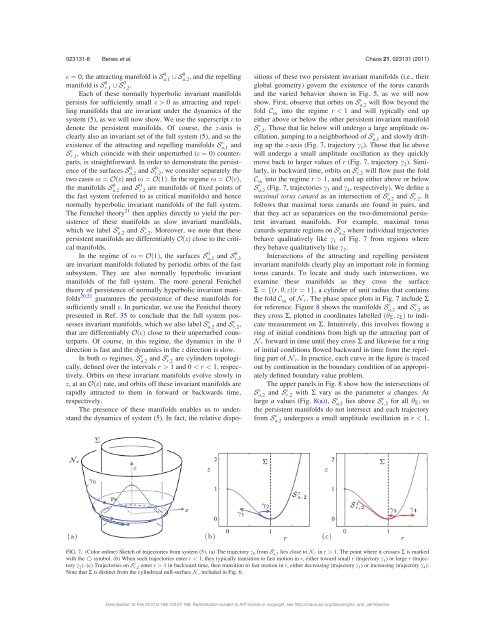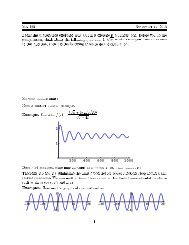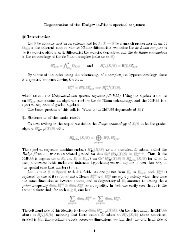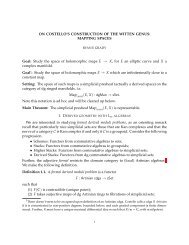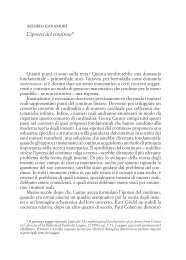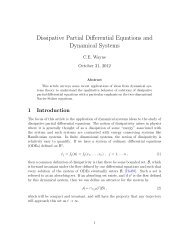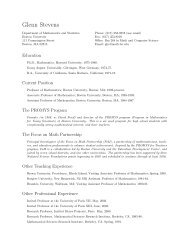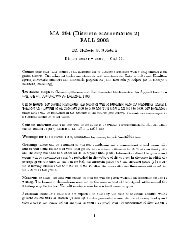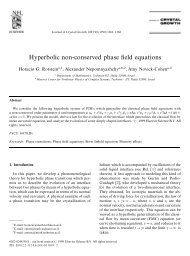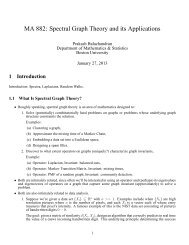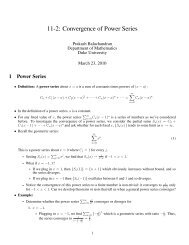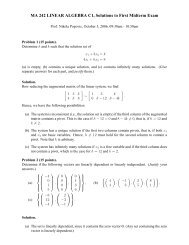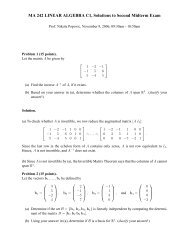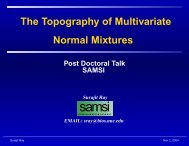An elementary model of torus canards - Mathematics & Statistics ...
An elementary model of torus canards - Mathematics & Statistics ...
An elementary model of torus canards - Mathematics & Statistics ...
You also want an ePaper? Increase the reach of your titles
YUMPU automatically turns print PDFs into web optimized ePapers that Google loves.
023131-8 Benes et al. Chaos 21, 023131 (2011)<br />
e ¼ 0, the attracting manifold is S 0<br />
a;1 [S0a;2<br />
, and the repelling<br />
manifold is S 0<br />
r;1 [S0r;2<br />
.<br />
Each <strong>of</strong> these normally hyperbolic invariant manifolds<br />
persists for sufficiently small e > 0 as attracting and repelling<br />
manifolds that are invariant under the dynamics <strong>of</strong> the<br />
system (5), as we will now show. We use the superscript e to<br />
denote the persistent manifolds. Of course, the z-axis is<br />
clearly also an invariant set <strong>of</strong> the full system (5), and so the<br />
existence <strong>of</strong> the attracting and repelling manifolds S e<br />
a;1 and<br />
S e<br />
r;1 , which coincide with their unperturbed (e ¼ 0) counterparts,<br />
is straightforward. In order to demonstrate the persistence<br />
<strong>of</strong> the surfaces S 0<br />
a;2 and S0r;2<br />
, we consider separately the<br />
two cases x ¼OðeÞand x ¼Oð1Þ. In the regime x ¼OðeÞ,<br />
the manifolds S 0<br />
a;2 and S0r;2<br />
are manifolds <strong>of</strong> fixed points <strong>of</strong><br />
the fast system (referred to as critical manifolds) and hence<br />
normally hyperbolic invariant manifolds <strong>of</strong> the full system.<br />
The Fenichel theory 21 then applies directly to yield the persistence<br />
<strong>of</strong> these manifolds as slow invariant manifolds,<br />
which we label S e<br />
a;2 and Ser;2<br />
. Moreover, we note that these<br />
persistent manifolds are differentiably OðeÞ close to the critical<br />
manifolds.<br />
In the regime <strong>of</strong> x ¼Oð1Þ, the surfaces S 0<br />
a;2 and S0r;2<br />
are invariant manifolds foliated by periodic orbits <strong>of</strong> the fast<br />
subsystem. They are also normally hyperbolic invariant<br />
manifolds <strong>of</strong> the full system. The more general Fenichel<br />
theory <strong>of</strong> persistence <strong>of</strong> normally hyperbolic invariant manifolds<br />
20,21 guarantees the persistence <strong>of</strong> these manifolds for<br />
sufficiently small e. In particular, we use the Fenichel theory<br />
presented in Ref. 35 to conclude that the full system possesses<br />
invariant manifolds, which we also label S e<br />
a;2 and Ser;2<br />
,<br />
that are differentiably OðeÞ close to their unperturbed counterparts.<br />
Of course, in this regime, the dynamics in the h<br />
direction is fast and the dynamics in the z direction is slow.<br />
In both x regimes, S e<br />
sitions <strong>of</strong> these two persistent invariant manifolds (i.e., their<br />
global geometry) govern the existence <strong>of</strong> the <strong>torus</strong> <strong>canards</strong><br />
and the varied behavior shown in Fig. 5, as we will now<br />
show. First, observe that orbits on S<br />
a;2 and Ser;2<br />
are cylinders topologically,<br />
defined over the intervals r > 1 and 0 < r < 1, respectively.<br />
Orbits on these invariant manifolds evolve slowly in<br />
z, at an OðeÞ rate, and orbits <strong>of</strong>f these invariant manifolds are<br />
rapidly attracted to them in forward or backwards time,<br />
respectively.<br />
The presence <strong>of</strong> these manifolds enables us to understand<br />
the dynamics <strong>of</strong> system (5). In fact, the relative dispo-<br />
e<br />
a;2 will flow beyond the<br />
fold C into the regime r < 1 and will typically end up<br />
SN<br />
either above or below the other persistent invariant manifold<br />
S e<br />
r;2 . Those that lie below will undergo a large amplitude oscillation,<br />
jumping to a neighborhood <strong>of</strong> S e<br />
a;1 and slowly drifting<br />
up the z-axis (Fig. 7, trajectory c1). Those that lie above<br />
will undergo a small amplitude oscillation as they quickly<br />
move back to larger values <strong>of</strong> r (Fig. 7, trajectory c2). Similarly,<br />
in backward time, orbits on S e<br />
r;2 will flow past the fold<br />
C into the regime r > 1, and end up either above or below<br />
SN<br />
S e<br />
a;2 (Fig. 7, trajectories c3 and c4, respectively). We define a<br />
maximal <strong>torus</strong> canard as an intersection <strong>of</strong> S e<br />
a;2 and Ser;2<br />
. It<br />
follows that maximal <strong>torus</strong> <strong>canards</strong> are found in pairs, and<br />
that they act as separatrices on the two-dimensional persistent<br />
invariant manifolds. For example, maximal <strong>torus</strong><br />
<strong>canards</strong> separate regions on S e<br />
a;2 where individual trajectories<br />
behave qualitatively like c1 <strong>of</strong> Fig. 7 from regions where<br />
they behave qualitatively like c2. Intersections <strong>of</strong> the attracting and repelling persistent<br />
invariant manifolds clearly play an important role in forming<br />
<strong>torus</strong> <strong>canards</strong>. To locate and study such intersections, we<br />
examine these manifolds as they cross the surface<br />
R ¼ fðr; h; zÞjr ¼ 1g, a cylinder <strong>of</strong> unit radius that contains<br />
the fold C <strong>of</strong> N SN r. The phase space plots in Fig. 7 include R<br />
for reference. Figure 8 shows the manifolds S e<br />
a;2 and Ser;2<br />
as<br />
they cross R, plotted in coordinates labelled ðhR; zRÞ to indicate<br />
measurement on R. Intuitively, this involves flowing a<br />
ring <strong>of</strong> initial conditions from high up the attracting part <strong>of</strong><br />
N r forward in time until they cross R and likewise for a ring<br />
<strong>of</strong> initial conditions flowed backward in time from the repelling<br />
part <strong>of</strong> N r. In practice, each curve in the figure is traced<br />
out by continuation in the boundary condition <strong>of</strong> an appropriately<br />
defined boundary value problem.<br />
The upper panels in Fig. 8 show how the intersections <strong>of</strong><br />
S e<br />
a;2 and Ser;2<br />
with R vary as the parameter a changes. At<br />
large a values (Fig. 8(a)), S e<br />
a;2 lies above Ser;2<br />
for all hR, so<br />
the persistent manifolds do not intersect and each trajectory<br />
undergoes a small amplitude oscillation in r < 1,<br />
from S e<br />
a;2<br />
FIG. 7. (Color online) Sketch <strong>of</strong> trajectories from system (5). (a) The trajectory c0 from S e<br />
a;2 lies close to N r in r > 1. The point where it crosses R is marked<br />
with the * symbol. (b) When such trajectories enter r < 1, they typically transition to fast motion in r, either toward small r (trajectory c1) or large r (trajectory<br />
c2). (c) Trajectories on S e<br />
r;2 enter r > 1 in backward time, then transition to fast motion in r, either decreasing (trajectory c3) or increasing (trajectory c4). Note that R is distinct from the cylindrical null-surface N z included in Fig. 6.<br />
Downloaded 18 Feb 2012 to 168.122.67.168. Redistribution subject to AIP license or copyright; see http://chaos.aip.org/about/rights_and_permissions


